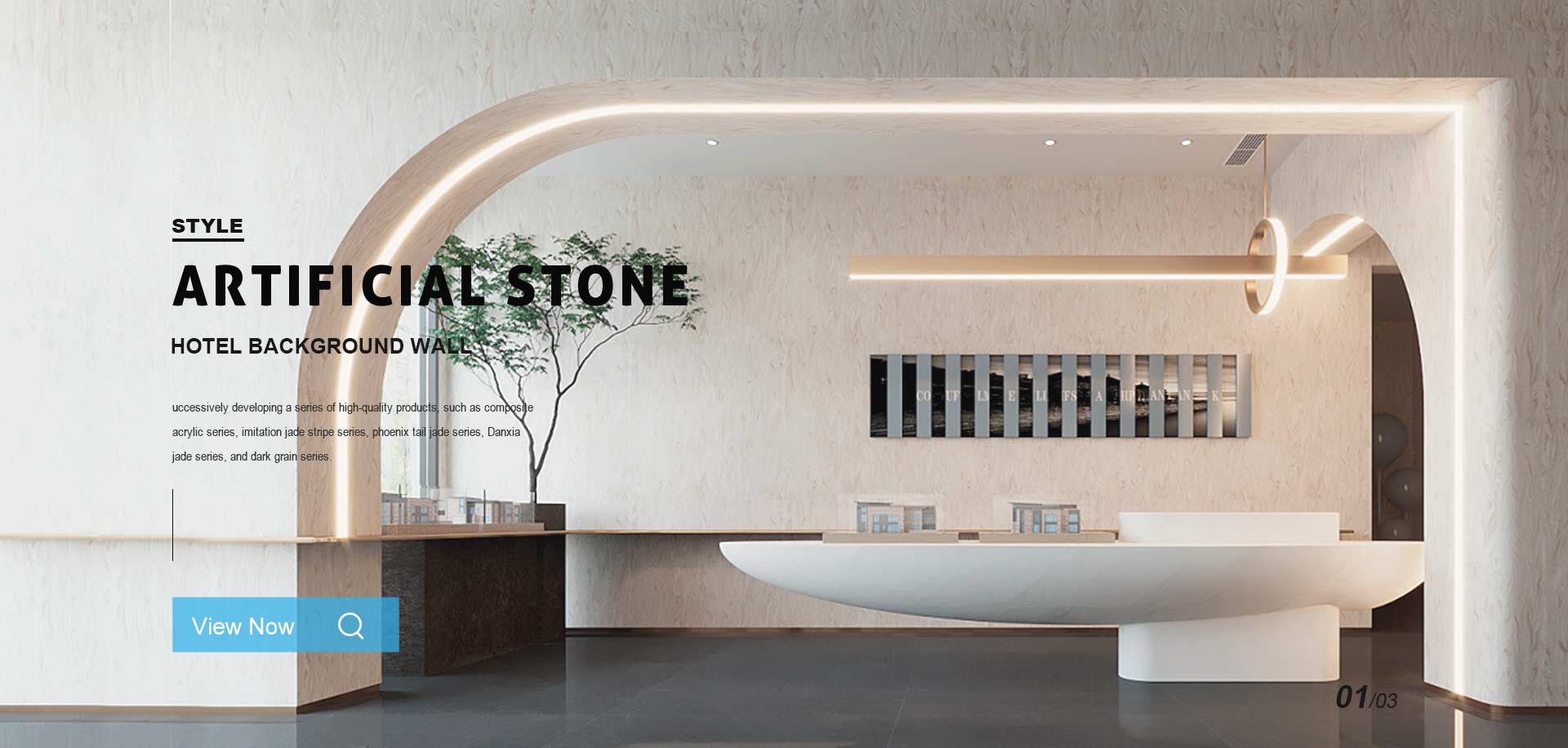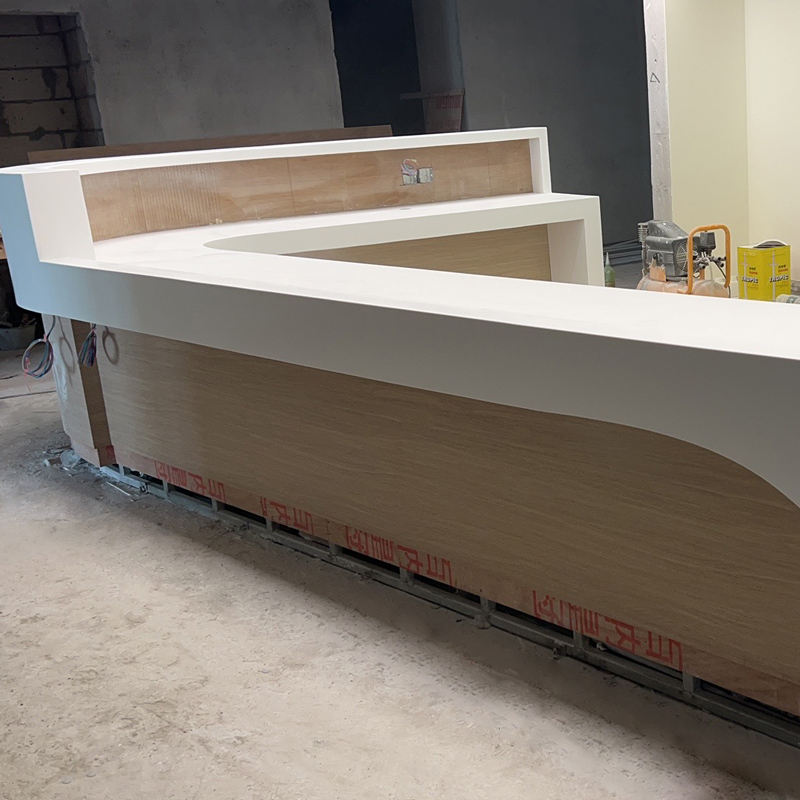
When choosing a reception desk for an office or commercial space, the material of the desk plays a crucial role in determining not only the aesthetic appeal but also the overall cost, durability, and maintenance requirements. Solid Surface custom-shaped reception desks, made from materials such as Corian, Staron, and HiMacs, have gained significant popularity in recent years. But how do they compare to more traditional options like wood or metal reception desks in terms of cost-effectiveness? This article delves into the benefits and drawbacks of each material, highlighting their value for money.

One of the standout features of Solid Surface Materials is their exceptional durability. Solid surface is a highly durable, non-porous material that resists stains, scratches, and impacts. It is also resistant to moisture, which is ideal for high-traffic areas like reception desks. The surface can be easily repaired, making it an excellent long-term investment. Scratches or dents can be buffed out or sanded away, which helps maintain its appearance for years to come.
Key Advantages:
Resistant to stains, moisture, and scratches.
Easy to repair, extending the life of the desk.
Maintains a smooth, high-quality finish over time.
Wood, while aesthetically pleasing and versatile, requires more maintenance than solid surface. Wooden desks are prone to scratching and may need to be refinished periodically. Additionally, wood is more vulnerable to moisture and can warp or discolor over time if not properly cared for. High-quality wood, such as hardwood, can be durable, but it typically requires regular sealing and maintenance to protect it from environmental factors.
Key Disadvantages:
Susceptible to scratching and wear.
Requires frequent maintenance (polishing, sealing).
Prone to moisture damage, which can lead to warping or discoloration.
Metal desks, often made from stainless steel or aluminum, are highly durable and resistant to corrosion. They also require minimal maintenance compared to wood, but they are not immune to dents or scratches, especially in high-traffic areas. Metal can become prone to fingerprints, smudges, and tarnishing over time, which can make it harder to maintain a pristine appearance. However, metal desks can last for decades with proper care.
Key Advantages:
Highly durable and corrosion-resistant.
Requires minimal maintenance.
Suitable for modern, industrial aesthetics.
Solid surface materials offer incredible design flexibility, especially when it comes to custom shapes and seamless designs. The material can be molded into virtually any shape, allowing for truly unique and customized reception desk designs. The seamless construction ensures that there are no visible joints, which contributes to a sleek, modern appearance. Solid Surface Desks are available in a variety of colors, textures, and finishes, offering almost limitless design possibilities.
Key Advantages:
Highly customizable in terms of shape and design.
Seamless construction for a sleek, modern look.
Wide range of color, texture, and finish options.
Wooden desks have a classic and timeless appeal. They offer warmth and richness that is hard to replicate with other materials. Wood can be easily stained or painted to match the décor of the space, offering a degree of customization. However, compared to solid surface, wood is more limited in terms of design flexibility—it is harder to shape into intricate designs and often requires joints or seams, which can impact the overall aesthetics.
Key Advantages:
Classic, warm, and elegant appearance.
Customizable through staining or painting.
Key Disadvantages:
Limited design flexibility.
Seams or joints may be visible.
Metal desks are typically associated with modern or industrial aesthetics. While they can have a sleek, contemporary look, their design flexibility is somewhat limited compared to wood or solid surface. Metal is best suited for minimalist, clean-cut designs, and may not fit in more traditional or warm environments.
Key Advantages:
Sleek, contemporary appearance.
Durability with a modern edge.
Key Disadvantages:
Limited customization options.
Can look cold or industrial in certain settings.
Solid surface reception desks can be more expensive than wood or metal desks, particularly when customized into intricate or complex shapes. The cost of the material itself can be higher, and the labor involved in creating custom designs also adds to the overall price. However, when considering the long-term benefits of durability, easy maintenance, and repairability, solid surface desks can offer better value over time. The cost of ownership is lower due to fewer repairs and maintenance needs, making it a more cost-effective choice in the long run.
Key Considerations:
Higher upfront cost, especially for custom designs.
Long-term value due to durability and low maintenance.
Easier to repair than wood or metal, reducing long-term costs.
Wooden reception desks tend to be more affordable upfront than solid surface desks, especially when using less expensive wood types or standard designs. However, ongoing maintenance costs (such as polishing, sealing, and repairing scratches) can add up over time. Additionally, wooden desks may require more frequent replacement or refinishing, which increases their total cost of ownership.
Key Considerations:
Lower initial cost.
Higher long-term maintenance and repair costs.
Requires periodic refinishing or sealing.
Metal reception desks fall in the mid-range in terms of cost. Stainless steel or aluminum desks can be affordable for the initial purchase, especially for simpler designs. Like solid surface, metal desks require less maintenance than wood, but they can still suffer from cosmetic damage (scratches or dents). Their durability and minimal maintenance needs often make them a good value-for-money option in the medium term.
Key Considerations:
Mid-range upfront cost.
Low maintenance and long-term durability.
Prone to cosmetic damage over time.
Solid surface is easy to clean and maintain, thanks to its non-porous surface. It does not absorb liquids, and stains or spills can be wiped away easily. Scratches can be sanded out, and the desk can be restored to its original condition without replacing the material. This low-maintenance quality makes it ideal for high-traffic areas.
Wooden desks require regular maintenance to protect against moisture, scratches, and stains. They must be polished periodically, and any damage to the surface may require professional refinishing. This can result in higher long-term maintenance costs.
Metal desks are relatively low-maintenance but are susceptible to fingerprints, smudges, and tarnishing. Regular cleaning with appropriate products can keep them looking sleek, but any dents or scratches may be harder to repair without professional help.
When comparing the cost-effectiveness of Solid Surface Custom Shaped Reception Desks with wood and metal alternatives, it's clear that solid surface offers excellent long-term value. While the initial cost may be higher, the durability, customization options, and low maintenance make it a smart investment for businesses looking for a desk that will stand the test of time.
Solid Surface: Higher initial investment but offers great value over time due to low maintenance and durability.
Wood: Lower upfront cost but higher long-term maintenance and repair costs.
Metal: Mid-range cost with good durability and minimal maintenance but may suffer from aesthetic damage over time.
Ultimately, choosing the right material for a reception desk depends on your specific needs, design preferences, and budget. However, for those prioritizing durability, flexibility, and ease of maintenance, a solid surface reception desk is an excellent choice.